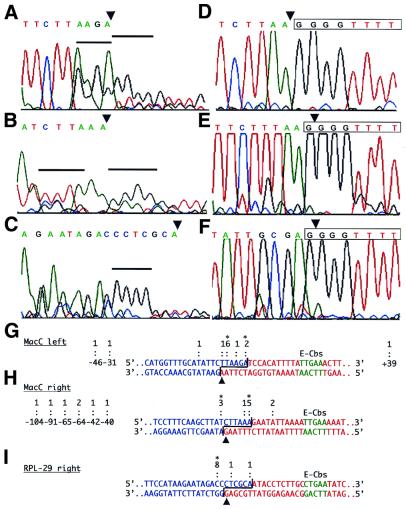Figure 4.
Sequence analyses of spacer-end and MAC-end PCR products. (A–C) Electropherograms from the direct sequencing of the spacer-end PCR products from 48/49 h DNA from the left spacer of MacC (A), the right spacer of MacC (B) and the right spacer of RPL-29 (C) are shown. The sequence above each electropherogram represents that of each spacer up to the 3′ end of the fragmentation intermediate. In each case, the observed sequence degenerates in quality approaching the end of the predicted fragmentation intermediate, suggesting that the PCR products represent a mixture with telomeres added at different positions. Blocks of four consecutive G residues that we interpret as the beginning of the telomeric repeats for a major subset(s) of the PCR products are indicated by the black horizontal bars. (D–F) Electropherograms from the sequencing of the MAC-end PCR products obtained from 48 h developing MAC DNA for the left and right ends of MacC and the right end of the RPL-29 MAC DNAs, respectively. The sequence of the region is given above the electropherogram, with the first telomeric repeat boxed. Note that for the MacC right end and the RPL-29 right end, the fragmentation intermediates end with a G residue, and this becomes part of the first telomeric repeat (12). (G–I) Summaries of the results from the bulk sequencing of PCR products and cloned PCR products. The MIC DNA sequences at the left and right ends of the MacC MAC-destined sequence and the right end of the RPL-29 MAC-destined sequence are shown. Based on the position of the E-Cbs core (green), and previous analyses (15), bases forming the spacer segment after fragmentation are shown in blue, whereas bases that form the MAC-destined sequence are shown in red. The brackets denote the six-base, 3′ overhangs of the fragmentation intermediates. Arrowheads below the sequences denote the positions of telomere addition (i.e. the nucleotide to which telomeric repeats are added) for the MAC-destined sequences based on bulk sequencing of MAC-end PCR products. Telomere addition sites for the spacers are indicated above each sequence: colons denote telomere addition sites inferred from sequencing cloned spacer-end PCR products, with the numbers above each colon indicating the number of clones obtained for each observed site; and asterisks denote the major telomere addition sites inferred from the bulk sequencing of PCR products. Also indicated to the left and right of the sequences are more distal positions of telomere addition observed in the clones. Numbering (e.g. –46) is based on designating the 3′ base of the spacer fragmentation intermediate as –1, with negative numbering extending into the spacer, and positive numbering into the MAC-destined sequence.

